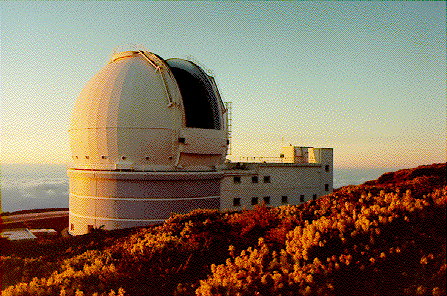
|
Dafydd's Photographs of
La Palma
|
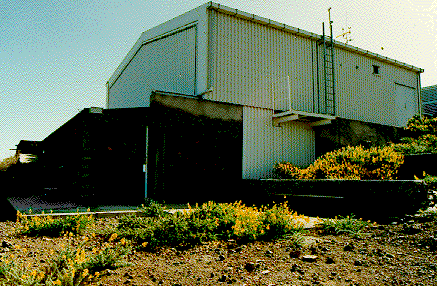
|
I used go to La Palma quite often and every now and then I would take some
photographs. I had thought on a number of occasions that it would be nice to
scan a few of these photos and put them in a web page. I always found that I
didn't have the time or opportunity to do it. Fortunately a collegue of mine
needed some La Palma pictures which had examples of codeso in them so at
long last some of these got scanned (I also got some non-codeso pictures
scanned as well). Thanks, Neil.
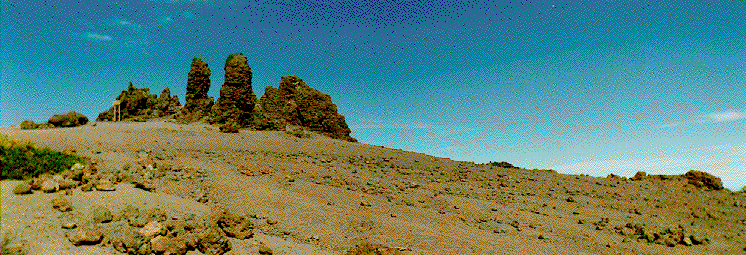
|
|
Los Muchachos
|
On a number of occasions I found myself doing multiple landscape shots with
the intention of forming a montage of the results. Since I was doing this, I
decided to
experiment with a disposable landscape camera and am
fairly pleased with the results (given the limitations of the equipment).
Three examples have been scanned. The first is the Los Muchachos right at
the top of the mountain which give
it and the observatory their names - Roque de los Muchachos.

|
|
Looking towards Teneguia over clouds.
|
The second is from the top of the Roque looking South towards the
volcanically active part of the island. The furthest mountain sticking out
of the clouds towards the right is the volcano of Teneguia. You can also see
most of the rim of the caldera of the old volcano. Hopefully the hot spot
has moved South since the observatory is situated on the edge of the caldera.
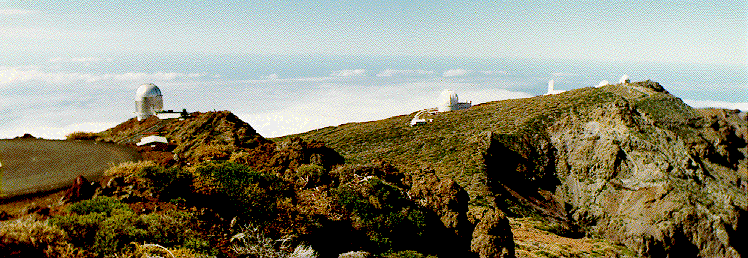
|
|
Almost all the telescopes at the Observatory.
|
The last example from the landscape camera is to the North from the Roque
and shows the majority of the telescopes at the observatory. Going from the
left you can see the
Nordic Optical Telescope,
the
Carlsberg Meridian Telescope,
the
William Herschel Telescope,
a Swedish solar tower, (the top of) the
Isaac Newton Telescope
and the
Jacobus Kapteyn Telescope.
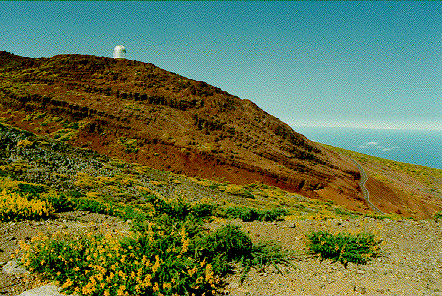
|
|
Codeso & NOT.
|
Here are some of the photos that I selected which had the codeso in bloom in
them. In case you're wondering, codeso looks very much like a gorse bush, but
has one significant advantage - it isn't prickly. I think it's part of the
laburnum family. While it does look pretty, it is a bit of a fire risk (see
later pictures). Leif Helmer had encouraged the codeso to grow as much as
possible around the Carlsberg so as to minimize problems with dust and the
ground heating up (and causing possible seeing problems). Anyway, this has
all changed since we've had to cut it all back from the telescopes. This
particular picture shows the view from the Carlsberg towards the NOT.

|
|
Carlsberg outside.
|
This is looking towards the Carlsberg from just below it. When the telescope
is observing the roof (we still call it a dome!) slides to the left enabling
the telescope to get a clear view of the sky.
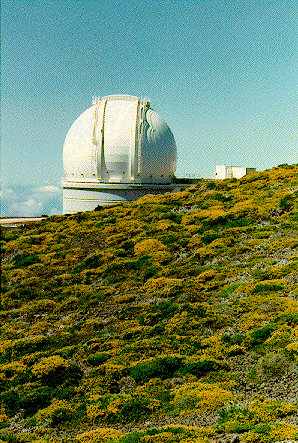
|
|
The WHT.
|
The William Herschel Telescope is a 4.2 metre telescope and currently
the largest on the island. I could write a bit about this telescope here
but it probably better if you want more information about the telescope to
look at the home page of the ING group. At least that should be up to
date.
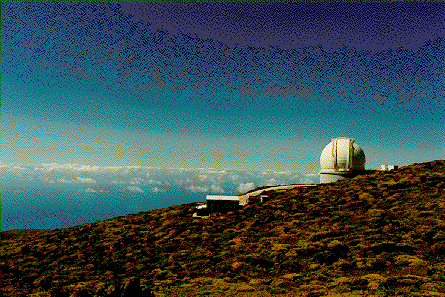
|
|
Carlsberg & WHT.
|
This is a view of the Carlsberg and the WHT from the South Azimuth mark. If
you walk from the Isaac Newton Group (ING) of telescopes towards the roque
(very easy now that ICONA have built a nice footpath all around the caldera)
you will probably encounter the South Azimuth mark of the Carlsberg.
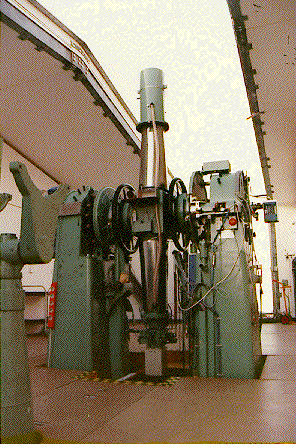
|
|
Carlsberg inside.
|
A picture of the inside of the Carlsberg with the dome open. Being a
meridian
instrument, the CMT only observes along one axis and doesn't swivel around
(the Earth does all the hard work). This means that the dome can be a very
simple construction and only has to open a small slit.
Some more pictures of telescopes.
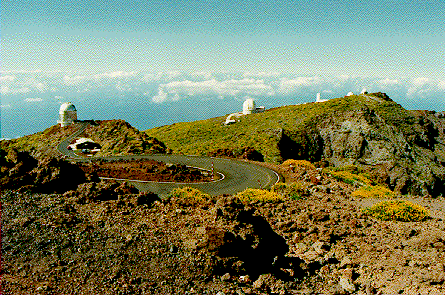
|
|
Almost all the telescopes at the Observatory, but not with a landscape camera.
|
|

|
|
The WHT at sunset.
|
|
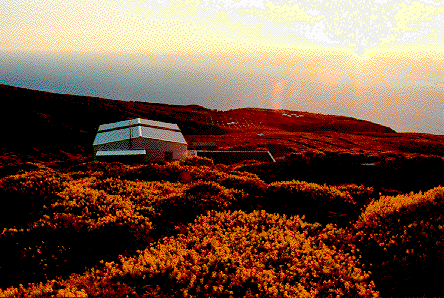
|
|
The Carlsberg at sunset.
|
|
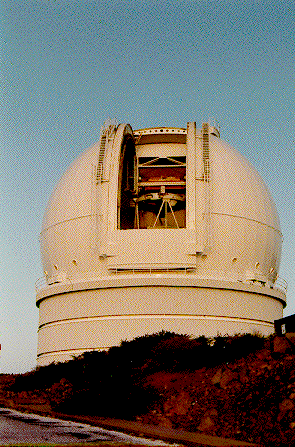
|
|
The WHT again.
|
|
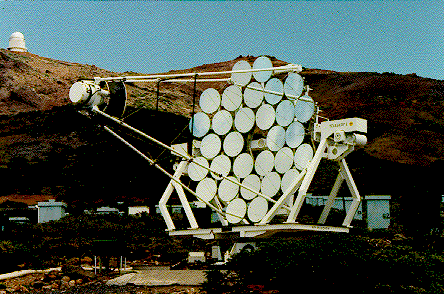
|
|
Part of the HEGRA project
|
|
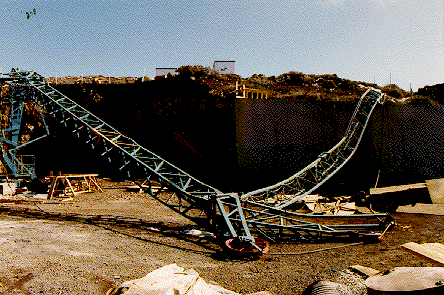
|
|
Broken crane.
|
This crane was on the building site of The Italian National Telescope
Galileo. During the winter
of 1993/4, too much ice built up on the structure of the crane and it
collapsed.
Some pictures of the landscape.
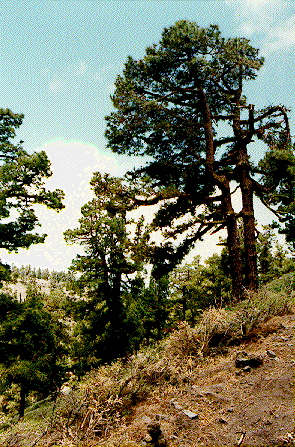
|
|
Pine Trees.
|
|
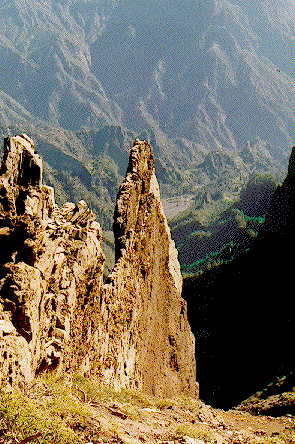
|
|
Pared & caldera.
|
|
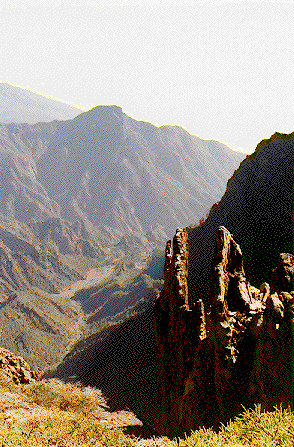
|
|
The caldera, looking towards Puerto Naos.
|
|
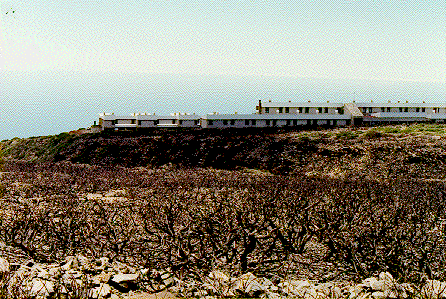
|
|
Burnt codeso in front of the Residencia.
|
There have been a number of forest fires that have affected the observatory.
Some of them have got quite close to the telescopes. This picture shows the
aftermath of the one that got close to the Residencia (where most astronomers stay).
So far, the only telescope that has been damaged by the forest fires are
some elements of the Hegra project.
A sad consequence of these fires is that the codeso bushes are now being cut
back from the telescopes, in order to reduce the fire risk to the instruments.
This can mean increased dust around the buildings and also the ground gets
heated up more during the day, causing larger seeing effects during the
early part of the night.
Most of these fires have been accidental, but some have been deliberate.

|

|

|

|
|
Some pictures from Claus Fabricius.
|
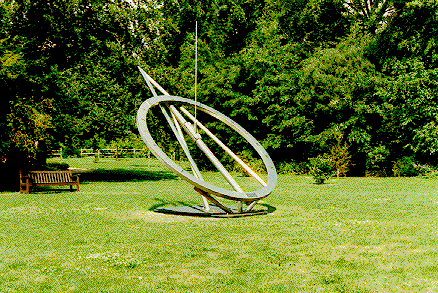
|
|
The RGO sundial.
|
Not La Palma, but associated with my work.
When the RGO moved from
Herstmonceux
to Cambridge the sundial moved as well. It was located just outside my office
at the RGO. When the RGO
closed, the sundial
moved back to
Herstmonceux Castle.
There is an RGO leaflet on the
Tercentenary Sundial.
 Back to DWE's Home Page
Back to DWE's Home Page
Dafydd Wyn Evans / IoA / dwe @ ast.cam.ac.uk
Last update 3 September 2007


















